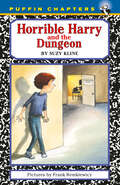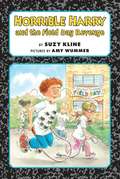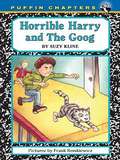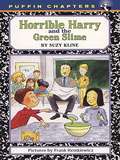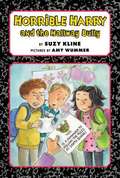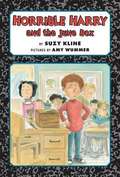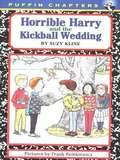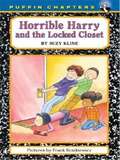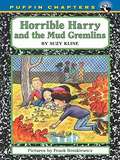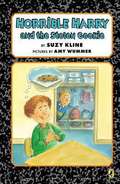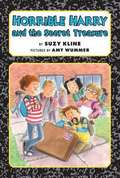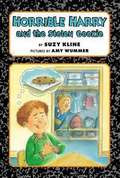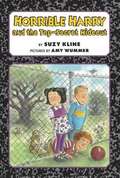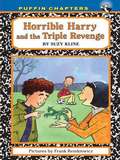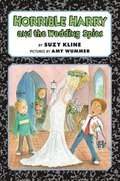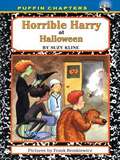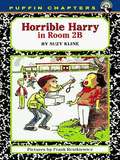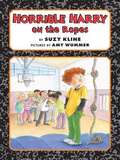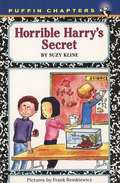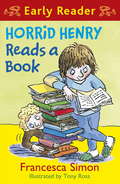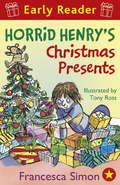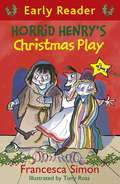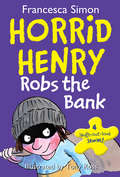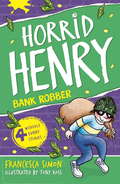- Table View
- List View
Horrible Harry and the Dungeon (Horrible Harry #9)
by Suzy KlineThere's a new rule at South School? If you misbehave, you go to the Suspension Room (or "the Dungeon," as the students of Room 2B call it). The rumors are flying about what actually goes on down there, but Harry won?t be satisfied until he finds out for himself.
Horrible Harry and the Field Day Revenge!
by Amy Wummer Suzy Weaver KlineHorrible Harry is at it again in a rollicking story of Field Day adventures, mishaps...and revenge!It’s one of the best days at South School: Field Day! That means bean bag tosses, relay races, and tug of war. When Mr. Deltoid announces students will pair up to compete for a mystery prize, Harry and Doug are determined to win. But at what cost? Harry's sneaky tactics leave Sid and Mary grumbling. They even claim he’s cheating. Harry insists he's playing fair and square. Doug doesn’t know what to think! He must prove his best friend is innocent before his classmates seek Field Day revenge. Can they win and play by the rules, or will the highlight of the year be a horrible disaster?
Horrible Harry and the Goog (Horrible Harry #22)
by Suzy Kline Frank RemkiewiczA secret teacher party is happening in the library, but who is the party for? Harry and Doug plan to find out, but when they discover Harry's pet cat, Googer, skulking around their classroom, they have to catch him before anyone else does! They chase The Goog all over school—even into places students (and cats) aren't allowed. Will the boys capture The Goog without being caught themselves? Or will Harry's cat get him into the most horrible trouble ever? .
Horrible Harry and the Green Slime (Horrible Harry #2)
by Suzy Kline Frank RemkiewiczHarry leads a mission to place cobwebs all over school, shows the class how to make green slime, and stages a "deadly skit" that has everyone on the edge of their seats.
Horrible Harry and the Hallway Bully (Horrible Harry #35)
by Suzy Kline Amy WummerNearly every kid in Room 3B is trying to get picked for the South School Safety Patrol Squad--especially Harry. Harry wants a star badge just like his grandpa's, so he works extra hard to be the perfect student: hanging up his jacket neatly, organizing the crayons in rainbow order, and--his favorite part--cleaning up sticky noodles off the floor after lunch. But Doug thinks someone is taking the power of Safety Patrol too far, maybe even using it to cheat at the Spring Book Fair Raffle! This is Harry's chance to stop the horrible bully and prove that he deserves a special star. Can he do it?
Horrible Harry and the June Box (Horrible Harry #31)
by Suzy KlineEveryone in Room 3B knows that if Miss Mackle sees you playing with toys at your desk, she'll confiscate them for her June Box. So when a substitute teacher catches good-girl Song Lee with a pink origami pig, into the June Box it goes. The problem is that this origami was to be a birthday present for Song Lee's grandmother. So Song Lee does the unthinkable: she breaks into the June Box to free her pig. Now Harry, Doug, and the rest of the kids have to work together--before they all wind up in horrible trouble!
Horrible Harry and the Kickball Wedding (Horrible Harry #6)
by Suzy KlineAs Valentine's Day nears, the students in Room 2B prepare for a possible wedding between Horrible Harry and Song Lee. Delightful. . . . The characters are real and the story is fresh. --School Library Journal
Horrible Harry and the Locked Closet (Horrible Harry #21)
by Suzy Kline Frank RemkiewiczAfter four days in a row of indoor recess, Miss Mackle's students are bored-until Harry decides to solve the biggest mystery ever in Room 3B! There's a locked closet in the classroom that's been sealed off for years, and he wants to know what's inside. So Harry drafts Doug, Song Lee, and the rest of the class to help him investigate. Their search reveals many surprises-from a hidden trapdoor to...eyeballs! What secret treasures does the closet hold? Is it something more horrible than even Harry can imagine?
Horrible Harry and the Missing Diamond (Horrible Harry #34)
by Suzy Kline Amy WummerWhen the diamond on Miss Mackle's engagement ring disappears, the kids in Room 3B are determined to help her find it--especially Harry. The third grade talent show is coming up, and he wants to show off his skills as South School's greatest detective. Meanwhile, Doug has no idea what to do for his act. He can't sing like Dexter, or dance like Ida, or solve mysteries like Harry. Now the best friends have to find both Doug's talent and the teacher's diamond, or else the talent show will be a horrible disaster for everyone!
Horrible Harry and the Mud Gremlins (Horrible Harry #20)
by Suzy KlineNo one knows why Harry is wearing a necklace. Sidney thinks they're for girls. But when Harry opens the necklace cover to reveal a mini-microscope, the whole class is intrigued. Everyone wants to try it, so Harry promises to show them all some wicked-looking fungi at recess. But he doesn't mentiom that to see them they'll need to go outside the fence-and that means breaking a school rule. Will everyone follow him? What if Miss Mackle finds out? Has Harry gone too far this time? Illustrated by Frank Remkiewicz. .
Horrible Harry and the Scarlet Scissors (Horrible Harry #32)
by Suzy Kline Amy WummerWill the best artist win? The art teacher asks the students of Room 3B to draw posters of things they love, and one of them will get to display his or her artwork on South School's brand-new TV show. Harry doesn't care about the contest. Mary, on the other hand, is convinced that her poster is the best, and she can't wait for her television debut. But if Mary's poster doesn't get selected, then she's going to make horrible trouble for Room 3B--especially Harry!
Horrible Harry and the Secret Treasure (Horrible Harry #30)
by Suzy KlineAnother fun mystery starring Horrible Harry, and this time he's calling the shots! Harry has always loved solving mysteries, and now his friends in Room 3B have learned to love it, too. So Harry challenges them to figure out what he has hidden in his giant, old suitcase. Led by a very determined Mary, the kids take turns solving clues and piecing the mystery together. Their hunt leads them from the classroom to the library, and even to Harry's grandfather's nursing home. Will they be able to solve Harry's mystery? Or will things go horribly wrong for the novice detectives?
Horrible Harry and the Stolen Cookie (Horrible Harry #33)
by Suzy Kline Amy WummerThe kids in Room 3B are holding a Sharing and Caring Tag Sale to earn money for charity. Song Lee and Ida are selling friendship bracelets, Doug is selling books, and Sid is selling delicious, fresh-baked chocolate chip cookies. But something else is on Harry's mind: his grandmother is having money trouble, and Harry wants to help. So he comes up with a plan to raise money for her. The problem is that Harry doesn't realize his plan involves stealing from the class's charity collection! How can Doug stop his friend from becoming a horrible thief? Could the answer come from one of Sid's delicious cookies?
Horrible Harry and the Top-Secret Hideout (Horrible Harry #37)
by Suzy Kline Amy WummerA story about appreciating and preserving the environment in your own backyard.Doug thought he knew everything about his best friend, Harry . . . until he discovers that Harry has a secret hideout in the woods just outside of South School.Unfortunately, Harry can't keep his hideout a secret much longer, because the land is going to be sold and turned into a big apartment building--unless he and the rest of the kids in Room 3B can save it. Harry has the idea to turn the lot into a nature center, and his friends want to help after he shows them the beautiful wildflowers, yellow spotted salamanders, and slimy tadpoles. But can Harry persuade the school board to agree, too? Or will his horrible fear come true: losing his hideout forever?
Horrible Harry and the Triple Revenge (Horrible Harry #24)
by Suzy KlineHorrible Harry has caused a lot of trouble at school, but this time, he?s taken it to a new level. When Sid ruins an origami insect Song Lee made, Harry defends her?by targeting Sid for some serious revenge. No one knows when, where, or how, but Harry is determined to get back at Sid! Will it be on Pajama Day, when the kids wear their PJs to school? Will it happen in Room 3B? Or will Harry?s horrible plan mean Sid is the only one not invited to Harry?s ninth birthday party? .
Horrible Harry and the Wedding Spies (Horrible Harry #36)
by Suzy Kline Amy WummerMiss Mackle is getting married! But she didn't invite any of her students to the wedding. The kids don't understand it: a wedding is a time for families to be together, and they are Miss Mackle's Room 3B family--which is especially important because her father is in the military overseas, and he won't be home for the wedding. So Harry comes up with a plan to sneak his pals into the wedding ceremony and hide in the back. It seems like the kids are going to make a horrible mess of their teacher's wedding . . . until they find a way to save the day for all involved.
Horrible Harry at Halloween (Horrible Harry #14)
by Suzy KlineHorrible Harry and his classmates all love Halloween. Everyone wears a costume to school-even Miss Mackle. Every Halloween Harry shocks his classmates with his scary costume. In kindergarten he was a bloody Count Dracula, in first grade he was the Loch Ness Monster, and in second grade he was a slithering snake. So everyone in Room 3B can't wait to see what Harry is going to be this year-and they're in for a really big surprise! "Fans will welcome the characters . . . #and the# classroom, where learning is as much fun as the tricks and treats!" (Booklist) .
Horrible Harry in Room 2B (Horrible Harry #1)
by Suzy KlineDoug discovers that though being Harry's best friend in Miss Mackle's second grade class isn't always easy, as Harry likes to do horrible things, it is often a lot of fun. .
Horrible Harry on the Ropes (Horrible Harry #28)
by Suzy KlineNormally, Harry loves gym class, and is better than the rest of Room 3B at just about every activity. But he's dreading the newest challenge-the climbing rope-especially since Sid is great at it. At first, Harry isn't even willing to try out the rope. But when a special valentine that Song Lee makes for him goes missing, Harry has to conquer his fears to prove who took it. Will he be able to climb up the rope? Or will his Valentine's Day end horribly?
Horrible Harry's Secret (Horrible Harry #4)
by Suzy KlineHarry's in love, and his best friend, Doug, is disgusted -- Harry won't even throw snowballs at girls anymore. Will Harry ever go back to being his horrible self?
Horrid Henry Early Reader: Book 10 (Horrid Henry Early Reader Ser.)
by Tony Ross Francesca SimonEarly Readers are stepping stones from picture books to reading books. A blue Early Reader is perfect for sharing and reading together. A red Early Reader is the next step on your reading journey.A reading competition? No way is Henry taking part in a reading contest. That is, until he hears the prize is a family trip to a theme park. Henry is determined to win ... but how on earth is he going to read all those books?
Horrid Henry Early Reader: Book 19 (Horrid Henry Early Reader Ser.)
by Tony Ross Francesca SimonThis year, Horrid Henry has a brilliant idea for his family's Christmas presents in this hilarious story. First appearing in Horrid Henry's Christmas Cracker, here the story is fully illustrated in colour in its own volume, perfect for Early Readers.Early Readers are stepping stones from picture books to reading books. A blue Early Reader is perfect for sharing and reading together. A red Early Reader is the next step on your reading journey.In this festive story, Horrid Henry has a brilliant idea for his family's Christmas presents. Who says he has to BUY them at all? It's the thought that counts! Early Readers - your child's stepping stone from picture books to reading books. This one is a perfect stocking filler, even for reluctant younger readers!
Horrid Henry Early Reader: Book 25
by Tony Ross Francesca SimonEarly Readers are stepping stones from picture books to reading books. A blue Early Reader is perfect for sharing and reading together. A red Early Reader is the next step on your reading journey.Horrid Henry is desperate to be Joseph in the school Christmas Nativity play. The trouble is, Miss Battle-Axe has made him the inn-keeper. There's only one thing for it - Henry's got to make his own part BIGGER!Full colour illustrations from the fabulous Tony Ross on every page!
Horrid Henry Robs the Bank
by Tony Ross Francesca SimonFour brand new stories in which Horrid Henry helps himself to all the money he needs to win his favorite board game, comes up with another spectacular money-making scheme for launching a newspaper with all the school gossip, vows vengeance on Perfect Peter when Peter steals his birthday party theme and has his own Pirate Party--and gets his revenge by taking over as head teacher when Peter plays school with his goody-goody friends.
Horrid Henry Robs the Bank: Book 17
by Francesca SimonHorrid Henry helps himself to all the money he needs to win his favourite board game, comes up with another spectacular money-making scheme for launching a newspaper with all the school gossip, vows vengeance on Perfect Peter when Peter nicks his birthday party theme and has his own Pirate Party ¿ and gets it by taking over as Head Teacher when Peter plays school with his goody-goody friends.
